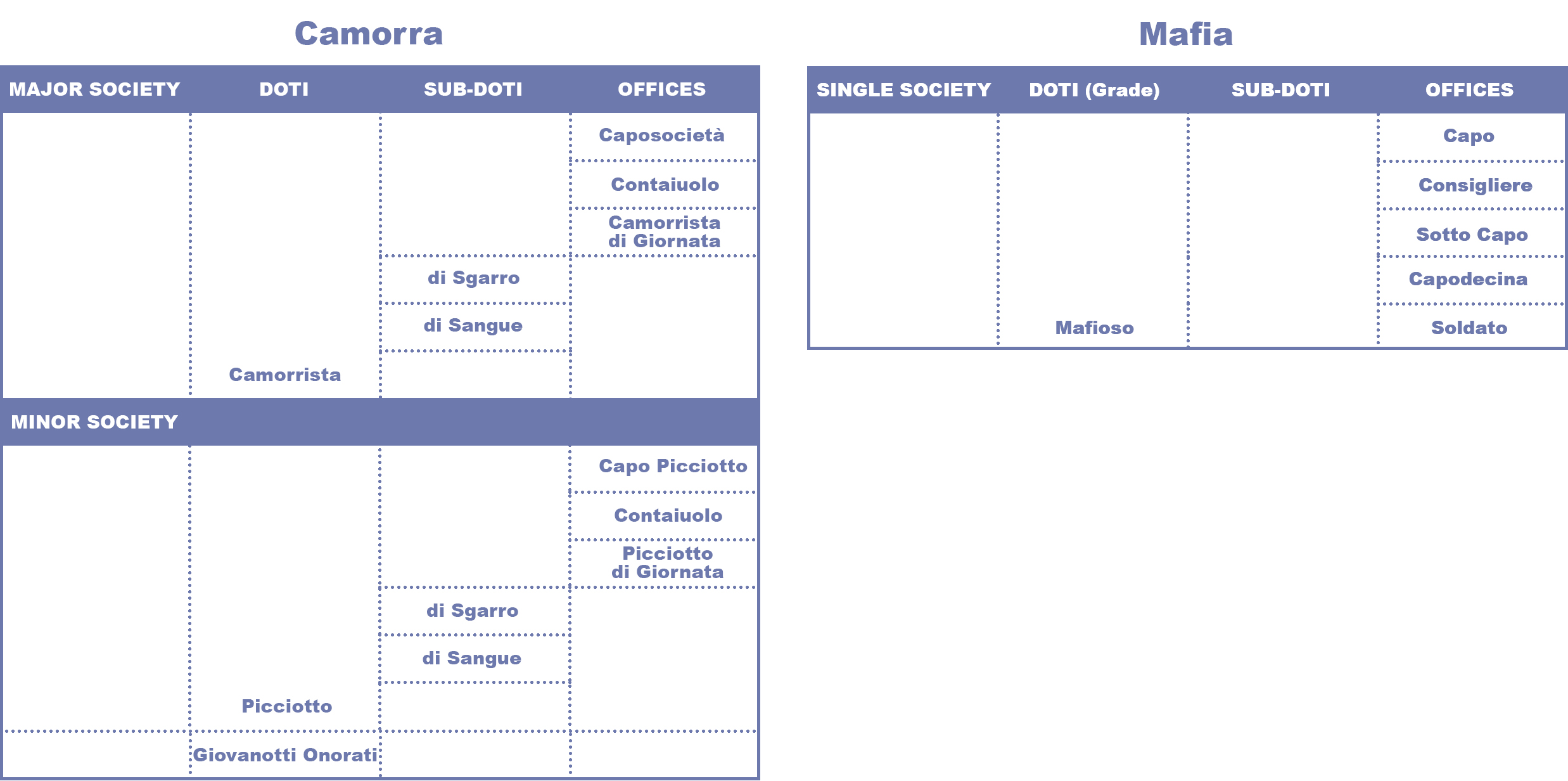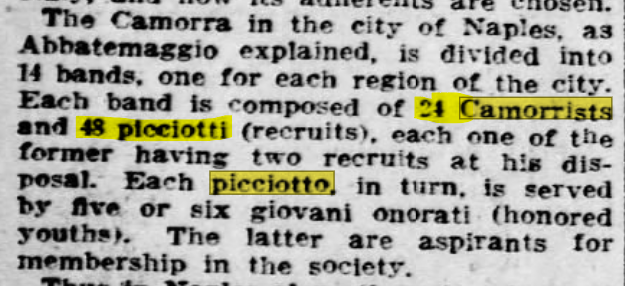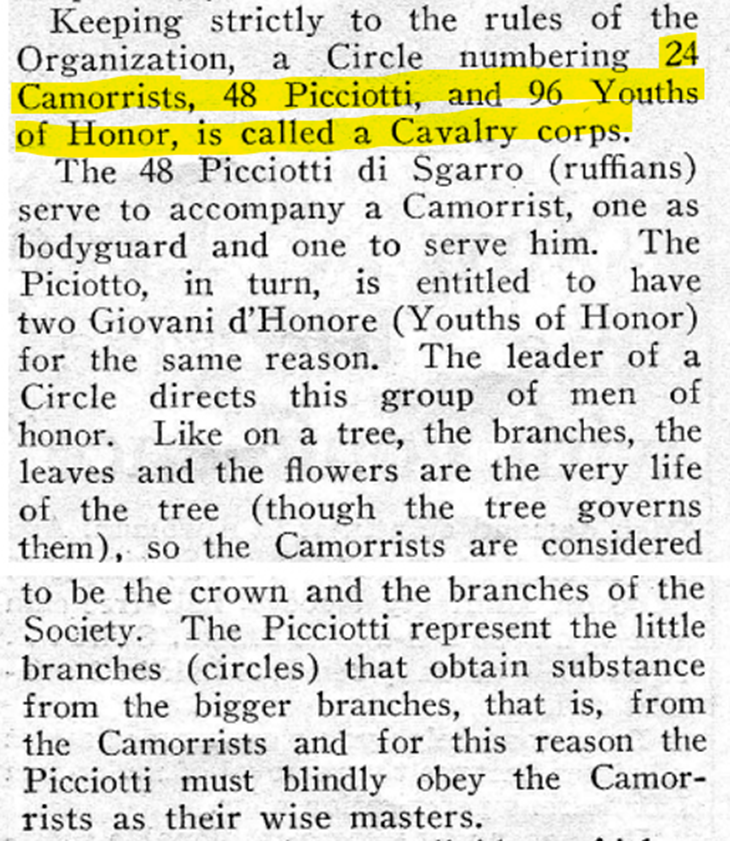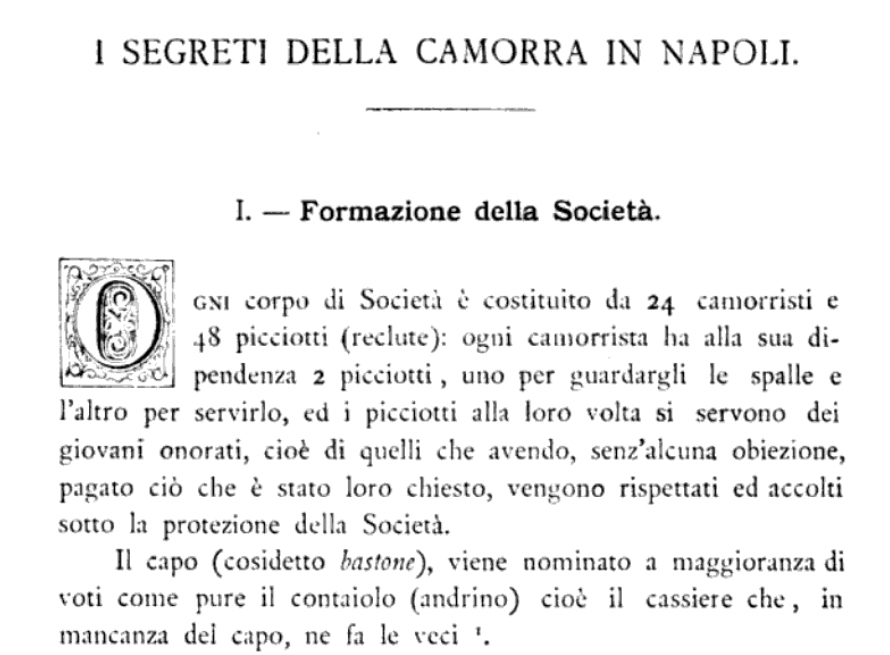TMA: The Camorra's Influence on American Cosa Nostra
Moderator: Capos
Re: TMA: The Camorra's Influence on American Cosa Nostra
Yep, Vizzini was living in Battle Creek too outside of Kalamazoo and from the best in can tell he was from the town of Agrigento or at least that area like Cavallaro. I'm not aware of any other mafiosi who lived in that part of Michigan. Rare to find an Agrigentino in the Detroit orbit though Detroit had its powerful Sancataldesi and a presence in Toledo and Youngstown. A background in Michigan also doesn't lend itself to close interactions with the Camorra that we know but I guess the melting pot of Youngstown opened new doors.
I thought the same about his last name, re: Johnstown haha.
I thought the same about his last name, re: Johnstown haha.
- PolackTony
- Filthy Few
- Posts: 5533
- Joined: Thu May 28, 2020 10:54 am
- Location: NYC/Chicago
Re: TMA: The Camorra's Influence on American Cosa Nostra
I hadn’t caught this myself in Daniele’s testimony, excellent find. Siniscalchi was from Quindici, Avellino (also the hometown of the Scibellis and Santaniellos of Springfield), and Pasqualina Albano was from the neighboring comune of Bracigliano, Salerno, which had a colony in Chicago as well as Springfield (Albanos from Bracigliano were longtime personal associates of Paul Ricca — himself a paesan’ of the Mirandas — and related to current Chicago member Mike Sarno).chin_gigante wrote: ↑Sat Mar 09, 2024 4:48 am Looking through that case book for the Pellegrino Morano trial, I found a Western Massachusetts connection that appeared quite interesting. From Ralph Daniello's testimony, Springfield bootlegger (and reported 'King of Little Italy') Carlo Siniscalchi attended a peace conference in Brooklyn between the Navy Street gang and the Grimaldis sometime in 1914-1915.
Siniscalchi, murdered in the South End of Springfield in 1921, was the husband of Pasqualina Albano. Following her spouse's killing, Pasqualina remarried to Antonio Miranda, the brother of future Genovese consigliere Mike Miranda.Q Then what business did you go into?
A I put up a restaurant at 37 Skillman Avenue. I was in partnership with Giovanni Mancini.
Q You and Mancini had this restaurant together in 1914, and how long did you have it there?
A I left the restaurant in the month of September or October of 1915.
Q While you had this restaurant, Alessandrio Vollero, Tony the shoemaker and two or three other members of the Navy Street gang came over to make peace with the Grimaldi family, because they had shot one of the Grimaldi’s; is that right?
A Yes, the shoemaker was not there, no. The Navy Street gang.
Q Are you sure the shoemaker did not come there?
A I am more than sure.
Q Well, the members of the Navy Street gang, Vollero and who else?
A Alessandrio Vollero, Andrea Ricci, Eugenio Bizarro, Lauritano, Joe Vaccaro, Vincenzo Parapalie, Salvatore Costa –
Q Do you remember the rest of the names, or is that all that came?
A I don’t remember the rest of the names, but I am sure that the shoemaker was there [sic].
Q Who of the Grimaldi family were there?
A John Grimaldi, Fury Grimaldi, Mike Grimaldi, Ralph Petrangelo, one Frank Riccio, one Baldassare, the barber, one Flippello from Coney Island.
[…]
Q Those men were all together in your restaurant?
A Yes, in my restaurant. Giovanni Mancini was also there. Giovanni Mancini, of course, was my partner, and there was a man from Springfield, Carlo Siniscaldi.
Q Was Mike Notaro there?
A No, sir.
Q After that conference over there between these rival people who had trouble, peace was patched up, was it?
A Yes.
Pasqualina herself was reported to be actively involved in bootlegging and was shot to death in 1932 (shortly after Antonio Miranda died). One of the suspected gunmen in Pasqualina's murder was Salvatore Celambrino, the same individual who was a identified as a member of the Miranda regime and later as a captain in his own right.
Quindici/Bracigliano are in the immediate orbit of Lauro, Avellino, a documented hub of Camorra activity in the early 20th Century and the hometown of Genoroso DelDuca. Sal Celambrino’s family was from Marigliano, the hometown of Boiardo; while Boiardo was closely tied to the Mazzochis in Newark, also from Lauro, Celambrino was in turn tied to the Laurese DelDuca. To trace out some more of these complex webs of connections, as B noted, Celambrino boasted about working for Capone, while Boiardo lived in the Taylor St neighborhood in Chicago as a kid, where DelDuca’s father and other relatives also lived for a number of years, while Pasqualina Albano very likely had relatives also living around Taylor St with ties to the network there.
Pasqualina Albano was obviously a player in her own right, which is likely pointing to another aspect of the old Camorra that was starkly different from the Sicilian mafia: the role of women. While many women in the Camorra’s orbit were trafficked prostitutes, they also had respected female affiliates and partners who worked as madams and procurers, as well as transporters of weapons and contraband. In some cases, women even became sworn members of the Honored Society, particularly in Calabria where a number of instances of this were documented and several women were recounted as killers (Calabria also had some notorious female brigand leaders in the 19th century, so there was some precedent to similar roles).
"Hey, hey, hey — this is America, baby! Survival of the fittest.”
- PolackTony
- Filthy Few
- Posts: 5533
- Joined: Thu May 28, 2020 10:54 am
- Location: NYC/Chicago
Re: TMA: The Camorra's Influence on American Cosa Nostra
It seems to have never totally “ended” per se, at least with respect to the Calabresi, as we see that as late as the 60s there was a Society remaining there coexisting with yet independent from LCN (even though the leaders were members of both organizations). We also have vague comments from the FBI that an Italian organization, not part of LCN and independent of both the Milwaukee and Chicago Families, remained active in Kenosha, WI, as late as the ‘80s (Kenosha being a city where the Italian community is majority Calabrian).Brovelli wrote: ↑Fri Mar 08, 2024 7:10 pm I haven’t watched the whole YouTube yet, so apologies if you covered this but is there a rough timeframe that the US Camorra no longer existed and fully “merged” with the mob? I could pick your guys brains all day so I apologize ahead of time for all my questions
As we can also see, it’s complicated by the fact that Canada remained an integral part of the transnational ‘Ndrangheta throughout this period, and at least by the 1960s we have accounts of ‘Ndrangheta “locali” being established via the Sidernese network in ON in US cities like NYC, Albany, Chicago, and some others. We don’t know to what degree these later branches had any meaningful continuity with networks already established in the US, such as this that we mainly focus on in the episode, but I suspect at least with Albany this may have been the case.
"Hey, hey, hey — this is America, baby! Survival of the fittest.”
Re: TMA: The Camorra's Influence on American Cosa Nostra
Interesting, I never knew it was so large nor lived for so long simultaneously with the “mafia”.
- Angelo Santino
- Filthy Few
- Posts: 6503
- Joined: Sat Oct 25, 2014 8:15 am
Re: TMA: The Camorra's Influence on American Cosa Nostra
Does this make sense? In working on this project I realize people are from a mafia perspective which is why it's good to compare and contrast. As much as they share similarities they are very different beasts, structurally speaking. And this applies to the 'ndrangheta today if compared to the Mafia.


- chin_gigante
- Full Patched
- Posts: 2442
- Joined: Wed Aug 08, 2018 11:36 pm
Re: TMA: The Camorra's Influence on American Cosa Nostra
That's probably the clearest visual representation of the structure I've seen, and the most self-explanatory when it comes to the difference between the doti and the offices and how it contrasts with the mafia. Very well done.Angelo Santino wrote: ↑Fri Mar 15, 2024 9:06 am Does this make sense? In working on this project I realize people are from a mafia perspective which is why it's good to compare and contrast. As much as they share similarities they are very different beasts, structurally speaking. And this applies to the 'ndrangheta today if compared to the Mafia.

It may also be best to include associates in the space outside the mafia society table, as anyone coming to this from a mafia perspective may be confused as to how they fit in. It would also highlight how the mafia filters individuals before permitting them for entry into the society, while the camorra (and today the 'ndrangheta) instead filters its recruits from within the dual societies.
'You don't go crucifying people outside a church; not on Good Friday.'
- motorfab
- Full Patched
- Posts: 2528
- Joined: Sat Aug 12, 2017 2:07 am
- Location: Grenoble, France
- Contact:
Re: TMA: The Camorra's Influence on American Cosa Nostra
Maybe include the ranks of Capo Mandamento & Capo Provincia for the mafia?
- Angelo Santino
- Filthy Few
- Posts: 6503
- Joined: Sat Oct 25, 2014 8:15 am
Re: TMA: The Camorra's Influence on American Cosa Nostra
That would work if I was delving into the current stuff but the focus is more on the 19th and early 20th century system.
- motorfab
- Full Patched
- Posts: 2528
- Joined: Sat Aug 12, 2017 2:07 am
- Location: Grenoble, France
- Contact:
Re: TMA: The Camorra's Influence on American Cosa Nostra
I thought these ranks existed in the early XXth century, but maybe I'm confusing, my bad
Re: TMA: The Camorra's Influence on American Cosa Nostra
Mandamenti was a later development to the best of our knowledge but capoprovincia goes back much further before the organization of the modern mandamenti system.
Capoprovincia goes back to at least the 1920s and it's possible the Palermo "capo supremo" in the SanGiorgi Report is evidence of its existence in the 19th century.
Capoprovincia goes back to at least the 1920s and it's possible the Palermo "capo supremo" in the SanGiorgi Report is evidence of its existence in the 19th century.
-
CabriniGreen
- Full Patched
- Posts: 3109
- Joined: Thu Jul 06, 2017 6:09 am
Re: TMA: The Camorra's Influence on American Cosa Nostra
I keep forgetting.. but I got a few questions..
For one, have you guys encountered anyone from Crotone, Cosenza, or Cantazaro? Was this association present in those territories?
Modern Ndrangheta in Crotone is something of a mystery to me. Was it always a separate thing that developed in parallel? Or was there a Sundering at some point, like is it an offshoot of Reggio?
How long do you think the Glen Cove thing has existed?
For one, have you guys encountered anyone from Crotone, Cosenza, or Cantazaro? Was this association present in those territories?
Modern Ndrangheta in Crotone is something of a mystery to me. Was it always a separate thing that developed in parallel? Or was there a Sundering at some point, like is it an offshoot of Reggio?
How long do you think the Glen Cove thing has existed?
- Angelo Santino
- Filthy Few
- Posts: 6503
- Joined: Sat Oct 25, 2014 8:15 am
Re: TMA: The Camorra's Influence on American Cosa Nostra
Yes. Very much so. I have info on what was going on in the Lamezia Terme region in the 1880's and that element played a significant factor in Chicago Heights, Pittsburgh and Hester St in New York. I'll be going into it, history, names, photos, structure on both sides of the Atlantic.CabriniGreen wrote: ↑Sat Mar 16, 2024 2:30 am I keep forgetting.. but I got a few questions..
For one, have you guys encountered anyone from Crotone, Cosenza, or Cantazaro? Was this association present in those territories?
Modern Ndrangheta in Crotone is something of a mystery to me. Was it always a separate thing that developed in parallel? Or was there a Sundering at some point, like is it an offshoot of Reggio?
How long do you think the Glen Cove thing has existed?
When it comes to camorra and 'ndrangheta, the 'ndrangheta is an evolved version of camorra, "the camorra on steroids" as Tony coined it. The camorra was not just a Naples phenonemom, it was in the Province, in Bari, all over Calabria, and in Sicily. Separate branches of a larger system. At some point in the later half of the 20th century, the structure got changed in Reggio with camorristi and sgarristi being moved from the maggiore society into the minore and santista being created for the maggiore. This was a forced change and not everyone was on board with it. In Calabria, the further north you go, the more you run into these "bastardi" groups that aren't a formal part of the 'ndrangheta network, they are old-school camorra that didn't evolve- either refused or weren't selected- with the 'ndrangheta. And of course, go further north into Basilicata, Puglia and Campania and, to our knowledge, the camorra didn't survive Mussolini's onslaught. So in short, the Calabrians were left holding the bag and they took it and made it their own. They are directly or indirectly responsible for the formation of the NCO and the SCU. Raffaele Cutolo joined the 'ndrangheta in prison and was well-read about the old camorra and wished to revive it. He tried to expand into Puglia and this caused some to go running to the 'ndrangheta who orchestrated the formation of the SCU.
You can look at the codici from before and after the 70's to see the evolution from camorra into the 'ndrangheta.
- Angelo Santino
- Filthy Few
- Posts: 6503
- Joined: Sat Oct 25, 2014 8:15 am
Re: TMA: The Camorra's Influence on American Cosa Nostra
From the 1911 trial:

From the Calabrian Camorra "book" confiscated in 1927:


From the Calabrian Camorra "book" confiscated in 1927:

- PolackTony
- Filthy Few
- Posts: 5533
- Joined: Thu May 28, 2020 10:54 am
- Location: NYC/Chicago
Re: TMA: The Camorra's Influence on American Cosa Nostra
And to further contextualize the 1928 Olean book, from the codice seized in 1971 from Francesco Caccamo in the Toronto (itself a transcription of a codice seized in San Giorgio Morgeto in 1963):

In both instances, the unit being formed is called “Corpo di Cavalleria”. This term, to my knowledge and recollection, was not used by subsequent ‘Ndrangheta pentitti and it’s unclear to me exactly what it was. A Società/‘ndrina, depending on the source, only required 3-5 men to be formed and the Olean book is clearly not referring to ‘ndrine (translated as “branches” in the text) when it designates the “Corpo di Cavalleria”. Possible that this was an earlier equivalent to a locale.
Going farther back, in 1897, this description of the Campanian Camorra was published in a journal of Italian folklore (note also the use of bastone for a capo, something that we otherwise associate strictly with Calabria). As with the Olean book, each Camorrista was to be assigned two picciotti:

That same year, the court in Reggio Calabria Cittá gave this description (my translation):
“Each body [corpo] is formed by 24 Camorristi and 48 ‘Picciotti’ […] It has leaders and hierarchies. The leader elected by the majority of votes is called ‘bastone’”.
Worth noting also that multiples of 12 figure frequently in ‘Ndrangheta codici and ritual speech. Eg, a Camorrista “represents a lion tied with a chain of 24 silver links”; the Società is like a “bronze tower in the middle of the sea with 24 candles, 12 by day and 12 by night”; the camorra (street tax) is a “ball of blood” that “makes its rounds every 24 hours”, etc. The Olean book maintains the multiples of 12 with the prescribed number of Giovane D’Onore being 96, while the 1963/1971 version messes this up by adding two more Giovane.

In both instances, the unit being formed is called “Corpo di Cavalleria”. This term, to my knowledge and recollection, was not used by subsequent ‘Ndrangheta pentitti and it’s unclear to me exactly what it was. A Società/‘ndrina, depending on the source, only required 3-5 men to be formed and the Olean book is clearly not referring to ‘ndrine (translated as “branches” in the text) when it designates the “Corpo di Cavalleria”. Possible that this was an earlier equivalent to a locale.
Going farther back, in 1897, this description of the Campanian Camorra was published in a journal of Italian folklore (note also the use of bastone for a capo, something that we otherwise associate strictly with Calabria). As with the Olean book, each Camorrista was to be assigned two picciotti:

That same year, the court in Reggio Calabria Cittá gave this description (my translation):
“Each body [corpo] is formed by 24 Camorristi and 48 ‘Picciotti’ […] It has leaders and hierarchies. The leader elected by the majority of votes is called ‘bastone’”.
Worth noting also that multiples of 12 figure frequently in ‘Ndrangheta codici and ritual speech. Eg, a Camorrista “represents a lion tied with a chain of 24 silver links”; the Società is like a “bronze tower in the middle of the sea with 24 candles, 12 by day and 12 by night”; the camorra (street tax) is a “ball of blood” that “makes its rounds every 24 hours”, etc. The Olean book maintains the multiples of 12 with the prescribed number of Giovane D’Onore being 96, while the 1963/1971 version messes this up by adding two more Giovane.
"Hey, hey, hey — this is America, baby! Survival of the fittest.”
- PolackTony
- Filthy Few
- Posts: 5533
- Joined: Thu May 28, 2020 10:54 am
- Location: NYC/Chicago
Re: TMA: The Camorra's Influence on American Cosa Nostra
One thing to keep in mind is that Crotone was administratively part of Catanzaro province until the 1990s. In the period that we mainly focus on here, the phenomenon was recorded in various localities across the old Catanzaro province (including Vibo Valentia then as well), though offhand I can’t think of any cases that I’ve seen where it was documented specifically in what is today Crotone province early on (it may have been there anyway, of course, as it was otherwise all over Calabria and criminals from Crotone would have been exposed to it in prison). We know from later pentitti, eg Giuseppe Vrenna, that the there was at least a locali in Crotone prior to the 1970s, which is when the modern stuff around Crotone seems to have really picked up.CabriniGreen wrote: ↑Sat Mar 16, 2024 2:30 am For one, have you guys encountered anyone from Crotone, Cosenza, or Cantazaro? Was this association present in those territories?
Modern Ndrangheta in Crotone is something of a mystery to me. Was it always a separate thing that developed in parallel? Or was there a Sundering at some point, like is it an offshoot of Reggio.
There was a trial in 1903 in Cosenza Città of the “Onorata Società” or “Società di Malavita”. The leaders of the Cosenza Society had originally been initiated into the Camorra in prison some years before by adherents from Reggion Calabria. Of particular interest to me was the fact that the Cosenza Society was active in the cluster of towns just outside of the city of Cosenza, towns which have had strong immigration ties to both Chicago and Kenosha (Rende, Castrolibero, etc).
As Angelo noted, the phenomenon was documented in Catanzaro Città and the area around the modern city of Lamezia Terme beginning in the 1880s. Apart from RC province, it is clear that these sections of Catanzaro were the primary hotbed for the phenomenon during the late 19th to early 20th centuries.
"Hey, hey, hey — this is America, baby! Survival of the fittest.”